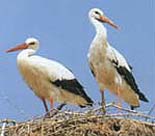| About China > Fauna & Flora > Class I Animals > Aves |
|
|
White Stork
With an alias of old stork, it belongs to the Ciconiidae family
of Ciconiiformes order. Its scientific name is
Ciconia ciconia (Latin), or White
Stork (English).
The bird is a large-size wading bird with a total body-length of about 120 centimeters. It has white body feathers, red eye periphery, and lace under the fore neck. Its scapular, wing tectus and remiges are black and with luster. It has long and stout black beak, with red legs and feet.
White Stork usually paddles in morass, swamp or pond side looking for food, and mainly feeds on fish, frogs and insects, etc. It is naturally restful and alert, slow in flying and walking, and usually stand with mono-podia when having rest. The bird begins breeding in March, and will then build nest on high mega-phanerophytes or buildings, and spawn 3 to 5 eggs per nest. The eggs are usually white, and are taken care of by male and female birds in turns. The incubation period usually takes about 30 days.
White Stork usually breeds in regions like Xinjiang Autonomous Region, Heilongjiang Province, and Tibet Autonomous Region, and hibernate in downstream Yangtze River and the areas south to the river.
White Stork has been listed in Appendix I of International Trade Convention on Endangered Wild Animal and Plant Species. |
||||
 |
